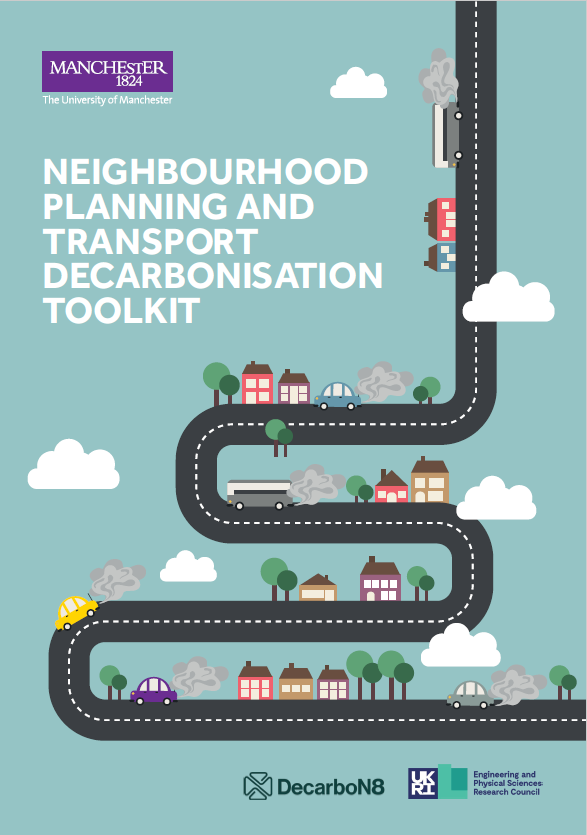by Caglar Koksal
Since 2016, transport (excluding international aviation and shipping) has been the largest emitter of greenhouse gases in the UK, with the large majority coming from road transport and, in particular, passenger cars (Department for Business, Energy & Industrial Strategy 2020). While total CO2 emissions in the UK have fallen by 43.1% between 1990 and 2018, the emissions from road transport have continued to grow, despite the availability of more energy efficient cars, because motor vehicle traffic volumes have generally increased throughout this period. It is well recognised that road transport plays a significant part in air pollution in urban environments and contributes to traffic congestion. This is estimated to cost approximately £7.8 billion per year to the UK’s economy due to productivity losses and fuel wastage (RTPI 2018).
In the midst of this change, over half of the UK local authorities have declared a climate emergency, pledging to act on the causes and impact of climate change and be carbon neutral as early as 2030. It is positive that almost one in four councils are seeking to radically exceed the government’s net zero target by 20 years. However, critics were quick to point out that many of these local authorities do not have a measurable and tangible action plan to deliver a lower carbon future (Electrical Contractors’ Association 2020; Climate Emergency UK 2022). Without the right policies and action plans in place, social acceptance and public support to overcome barriers – and accelerate transition – to lower carbon futures will also be limited.
What is Neighbourhood Planning?
By focusing on Neighbourhood Planning (NP), this research investigated and contributed to the development of a community-led and place-based solution to decarbonise travel choices and transport infrastructure.
NP was introduced by the Localism Act 2011 as part of the statutory development plan to give communities direct power to develop a shared vision for the development and growth of their neighbourhood areas. Since its introduction, NP has been proved to be very popular: with 2882 neighbourhood areas designated and 1292 plans having passed local referenda to become part of statutory development plans for their local area (as of November 2021).
However, there is a lack of practical and accessible toolkits helping communities to devise planning policies to decarbonise their travel choices and transport infrastructure. This is a missed opportunity. Although most transport powers rest with the County Council or Unitary Authorities as the statutory local transport authorities, neighbourhood planning can help reduce the need for car journeys and enable people to make sustainable transport choices by influencing the location, scale, density, design and mix of land uses at the neighbourhood level.
The thrust of neighbourhood planning as a tool to decarbonise local transport is that innovation, solutions and policies all come from the community and are then tested by all the residents through a local referendum. Therefore, in order to empower communities and to lead change to a just transition to lower carbon futures from the bottom up, it is crucial to identify practical ways of integrating sustainable transport policies into neighbourhood planning.
Neighbourhood Planning and Transport Decarbonisation Toolkit
To help communities, the authors of this blog created a toolkit to decarbonise local transport via neighbourhood plans, suggesting detailed strategies to adopt sustainable transport policies in neighbourhood plans and providing good practice examples.
This toolkit advocates a community-led, place-based approach to decarbonise local transport. This means that appropriate strategies and plans must come from the community (bottom up) and be tailored to the unique opportunities and challenges of the neighbourhood area. Therefore, this toolkit is designed in such a way to provide generic principles and methods of thinking that underpin a transport decarbonisation strategy. It also provides recent good practice examples from adopted neighbourhood plans to demonstrate how generic principles can be applied in real life.
Neighbourhood plans, and other bottom-up approaches to decarbonise and build climate resilience, empower the public to act and increase climate literacy. The climate crisis impacts everyone differently; therefore, it is important to give the right messages to the right people. The toolkit addresses that by demonstrating different wider outcomes of different pathways to the decarbonisation of transport, i.e. co-benefits. For example, reducing the need to travel will also have a positive impact on the local economy as well as health (e.g. less congestion, more active travel).
The toolkit’s intended audience are neighbourhood forums and parish and town councils in England who are producing, or planning to produce, a neighbourhood plan. It is also aimed at Local Planning Authorities and Local Transport Authorities who are helping communities in the development of neighbourhood plans within their boundaries.

Neighbourhood Planning and Transport Decarbonisation Toolkit
This toolkit is regularly updated to reflect the changes to the planning system and good practices across England.

